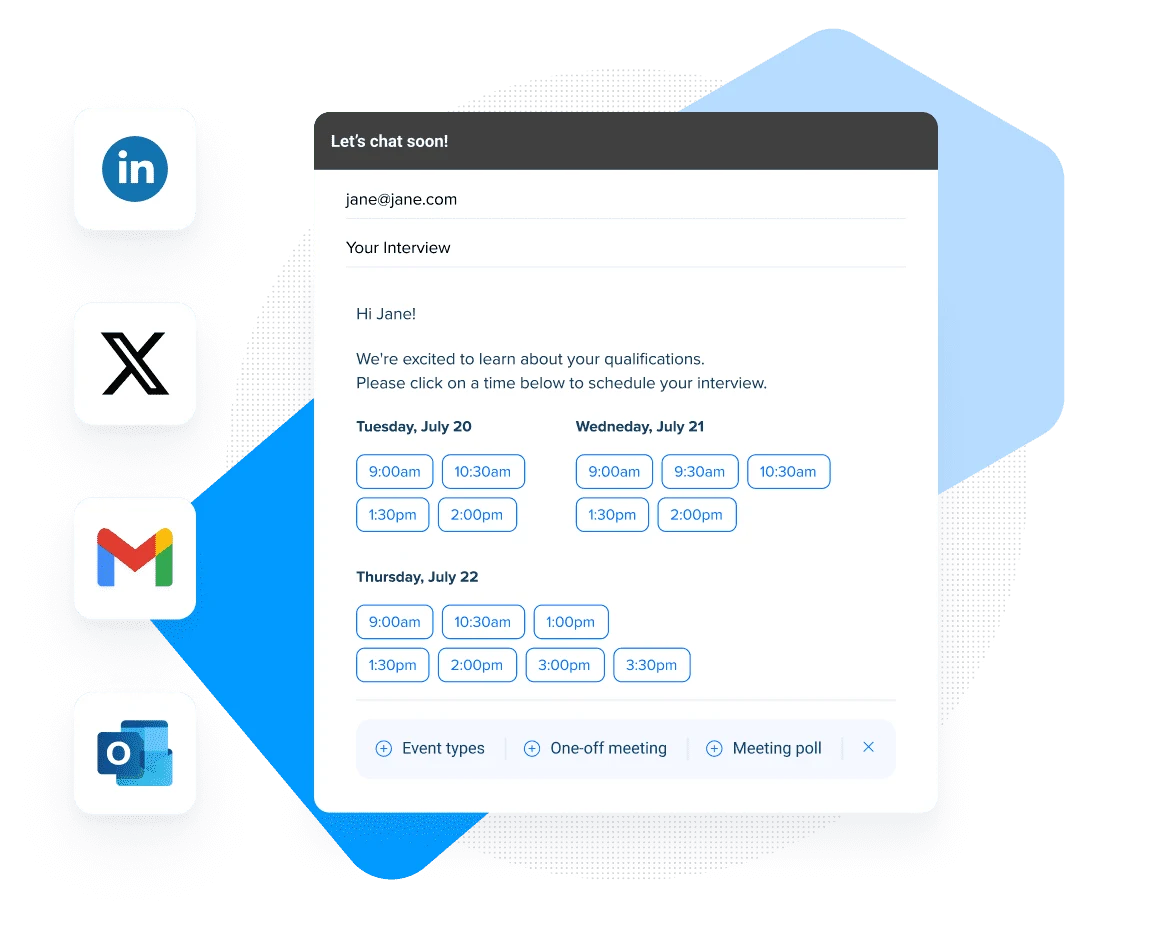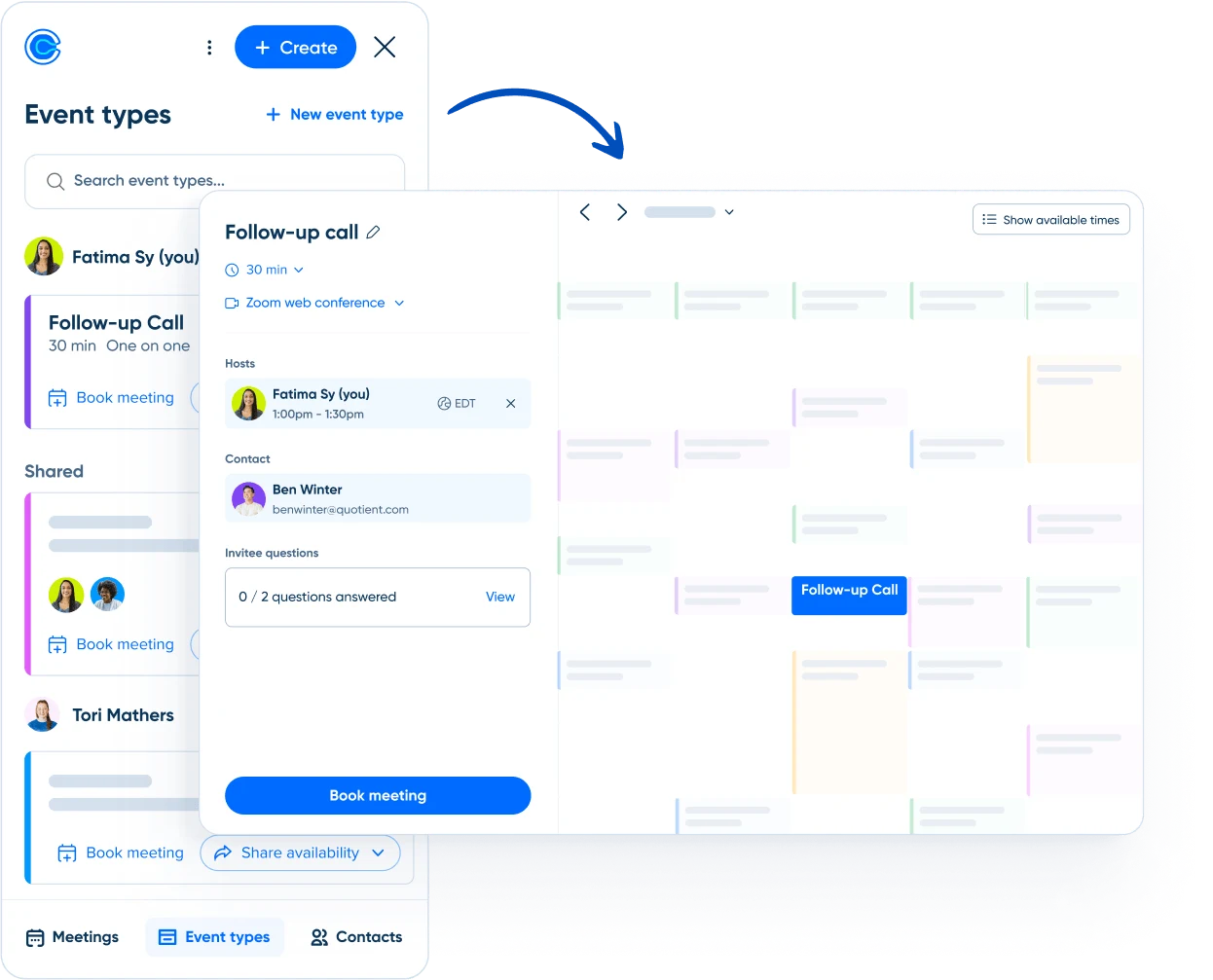How to find a meeting time that works for everyone
Skip the email back and forth and make it easy to find a meeting time with these tips.
Table of contents
In theory, scheduling meetings is simple: You just need to find a time when all attendees are available.
In practice, it can look more like this:
You’re juggling competing priorities, calculating five different time zones, and navigating reply-all email threads. Not to mention a whole bunch of other factors:
All participants’ schedules
Meeting duration
Meeting location (In-person? Virtual? Hybrid?)
Whether you’re scheduling team meetings, sales calls, customer onboarding, or group interviews, make finding meeting times easier for you and your invitees with scheduling software.
In this article, we’ll walk through how to use a scheduling tool like Calendly to find a meeting time that works for everyone (and create a better scheduling experience for everyone).
6 ways to find a meeting time with Calendly
Calendly is an online scheduling app that takes the time-consuming admin work out of scheduling meetings. Here’s how using a meeting scheduler like Calendly helps you book meetings more easily and efficiently.
1. Share your scheduling link
A Calendly study found it takes an average of 7.3 emails to schedule a meeting. That’s way too much of your invitee’s time (and yours!). Make it easy to find a meeting time by adding a Calendly link to your meeting invitation email.
Here’s how Calendly works:
You connect your work and/or personal calendar(s) to Calendly and set your available hours, so you don’t have to worry about double booking. Calendly syncs with Outlook, Exchange, and Google Calendar.
Calendly uses this info to show your available meeting times on your booking page. (No one can see the details of your whole calendar — Calendly only shows your available time slots.)
When you share your Calendly booking page, invitees can quickly see your availability. Available times are automatically shown in invitees’ time zones, so nobody has to do mental math.
Invitees choose their preferred time and, in less than a minute, your meeting is scheduled!
You can also connect your video conferencing software (like Zoom, Microsoft Teams, and Google Meet). Calendly will automatically generate video conferencing details when someone schedules with you, so you and your invitees don’t have to waste time trying to hunt down a meeting link.
Pro tip: Meeting request etiquette
The way you frame your scheduling link matters! Scheduling links have become commonplace in some industries, while some invitees may be totally unfamiliar with the concept.
Instead of “Here’s my Calendly link!”, consider asking your invitee for their availability first, then share your booking URL as an option for easier scheduling: “What dates and times work for you? If it’s easier, you can also choose a time that works for you using my Calendly link: [Calendly Link].”
Get more scheduling etiquette tips for sharing your Calendly link.
2. Add available times directly to your email
Let invitees choose a meeting time right from their inbox by adding clickable available dates and times directly into the body of an email. (If none of the times listed work for your invitee, they can click “See full list of times” to be taken to your booking page.)
The Calendly browser extension for Chrome, Edge, Firefox, and Safari makes it super simple to add your appointment scheduling link to meeting invitations without having to jump between tabs or apps. In just a few clicks, you can share your scheduling link or add your available times in Gmail, Outlook, LinkedIn messages, social media, or anywhere else on the web.
“[The browser extension] makes it so easy to send Calendly links and schedule with my partners and prospects.”
Sarah Pinner
Co-founder at Beni
The State of Meetings 2024
3. Find the best time for a one-off group meeting with Meeting Polls
Trying to get a big group together for a one-off meeting like a project kickoff or sales proposal? Skip the calendar cross-referencing and automate group scheduling by sending out a Calendly Meeting Poll.
Your invitees vote on their preferred meeting times, so you can easily accommodate busy schedules and different time zones. Once everyone votes, you choose the best time. Calendly schedules the new event for you, then automatically sends calendar invites and meeting details to everyone who voted.
“Managing more than 20 projects at a time, Calendly makes herding cats and linking calendars a breeze. Not only does [Meeting Polls] allow you to invite guests to pick dates and times that work best for them, it also fully integrates into your calendar, holding place markers for the times that work best for you.”
Thomas Rodriguez-Shucker
Senior Vice President of Client Services at Collaborative Research
Read more about Meeting Polls.
4. Co-host a meeting at a time that works for everyone
When you need multiple team members to co-host a meeting, Calendly’s Collective meetings pool the availability of everyone in a group. The invitee can only select meeting times that are open on every host’s calendar.
For example, at Calendly, account executives (AEs) and sales engineers (SEs) co-host demos. Calendly’s Collective events pool the availability of both hosts on one booking page. Enterprise AEs share the collective scheduling link in their email convo with prospects, and invitees can only select meeting times that are open on both the AE and SE’s calendars.
“Calendly has also been a game changer for coordinating meetings with my AEs. Before having a tool like this, I would be booked over, not given notice, or booked after hours. It’s made for a much better experience for us and the customers!”
Dave Evatt
Senior Solutions Architect at Calendly
5. Offer more available meeting times with Round Robin scheduling
Round Robin scheduling automatically assigns meetings to team members. Calendly looks at the availability of every team member and assigns the meeting to a rotating host based on availability, team member priorities, or equal distribution.
This feature lets you respond to customers faster and offer them more available meeting times.
Let’s use inbound sales leads as an example. After a prospect fills out your contact form, you send them right to your sales team’s scheduling page. They book the meeting time that works best for them, and Calendly’s Round Robin feature automatically assigns the meeting to the next available sales rep. Your potential customer doesn’t have to wait around or go through a lengthy email back and forth to get a meeting scheduled, and your team can connect with a prospect at the peak of their interest — before the competition.
“We feel confident that when a lead comes in, it goes reliably to different team members. Calendly’s Round Robin feature saves a lot of headaches, especially when assigning which appointment goes to whom.”
Donald Kelly
Founder at The Sales Evangelist
6. Book a meeting in real time from the Calendly browser extension
Calendly's browser extension lets you book your next meeting on the spot — without having to send a scheduling link later on. This functionality is especially useful when you need to schedule a follow-up meeting with a lead or client.
For example, sales reps can schedule a product demo live at the end of the discovery call, so the deal keeps moving. “As the call wraps up, make sure to leave 7-9 minutes to guide prospects through the next steps,” says Morgan J. Ingram, Founder and CEO at Ascension Media Productions (AMP). “I book these meetings directly from Calendly's browser extension while still on the call. Calendar invites are sent before we end the call so you remove the possibility of being ghosted.”
Better meetings start with better scheduling
With Calendly, you can take the hassle out of scheduling and focus on what really matters — having productive, meaningful meetings. Whether you're coordinating with a team or connecting with customers, Calendly makes it easy to find a time that fits everyone's schedule. It’s a better meeting experience for you, your team, and your invitees.
See why 20 million people use Calendly for easy scheduling. Sign up for free.
Get started with Calendly
Ready to make scheduling easier than ever?
Related Articles
Don't leave your prospects, customers, and candidates waiting
Calendly eliminates the scheduling back and forth and helps you hit goals faster. Get started in seconds.







